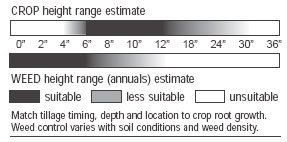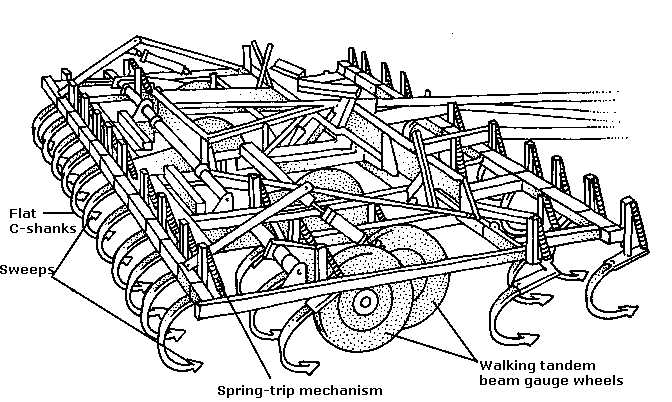Dryland Crops
Field Cultivator (with sweeps)

Overview: Shanks and sweeps much like those used on row-crop cultivators. Shanks stagger-spaced on four or five toolbars to do broadcast tillage 2" to 5" deep across the full tool width. Field cultivators are widely used in mulch-tillage of relatively light residue, low herbicide systems to control successive flushes of weeds prior to planting. Wide, low-profile sweeps (6" to 12" on C-shanks, 3" to 11" on S-tines) optimize weed control and minimize soil mixing. Also used widely for secondary preplant tillage. Leaves 50 to 75 percent residue; impact varies with speed and sweep design.
Design Features: Shanks fasten directly to a toolbar without the parallel linkage of row-crop cultivators. Spring cushioned or spring-trip auto-reset shanks recommended for soils with underground obstructions. Net spacing (of all shanks on all toolbars) is 4" to 7" for S-tines, 6" to 9" for C-shanks.
The high number of shanks disturbs residue and opens the soil surface to drying more than other shanked, dryland implements. Some C-shanks are 'edge-bent' (formed so that the narrow dimension of the shank faces forward on the bottom half of the shank) for greater strength and stability with less soil impact and horsepower drag. C-shank stock for field cultivators ranges from 0.5" to 0.88" thick and 1.75" to 2" wide.
Vertical clearance is 20" to 27", sweep tip to bottom of toolbar. Spike-tooth or straight flex-tine harrow attachments often added to level soil, control weeds and incorporate chemicals.
Integral (3-point hitch) models maximum 25' wide; drawn type for wider versions.

Model for comparison: 22' folding frame, drawn/pull type
Rec. PTO HP: 125
Speed: 4 to 7 mph
List price: $7,940 to $18,000*
* Includes three-point hitch type and drawn/pull type
Width range (all makers/all models): 12' to 62'
Sources: 18, 21, 28, 33, 46, 58, 64, 65, 76
Farmers: Fernholz, Harlow, Jacobson
